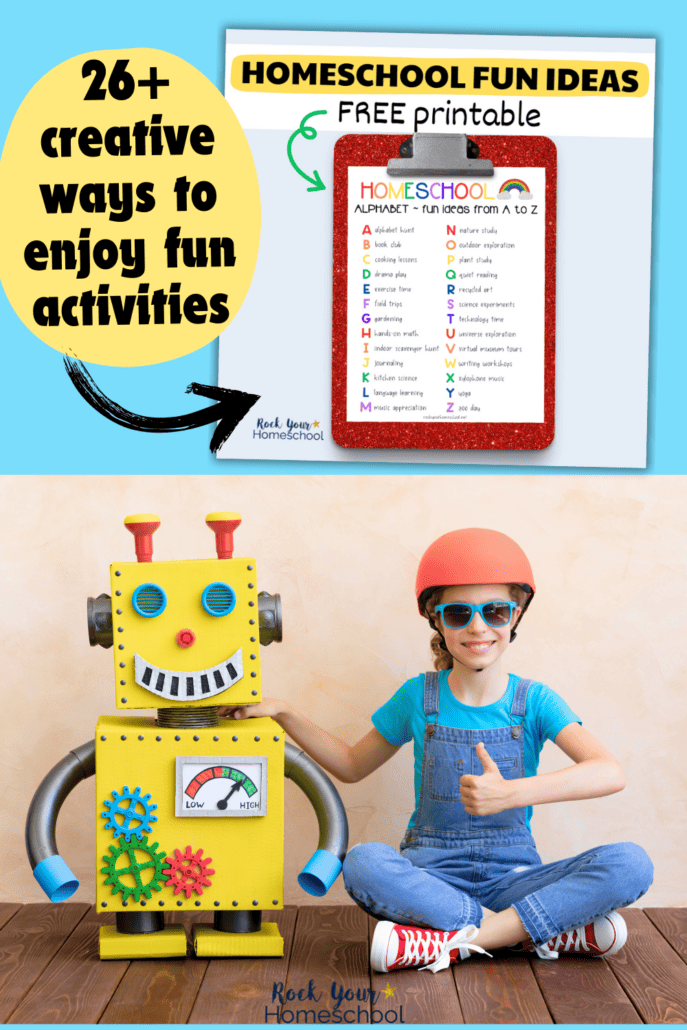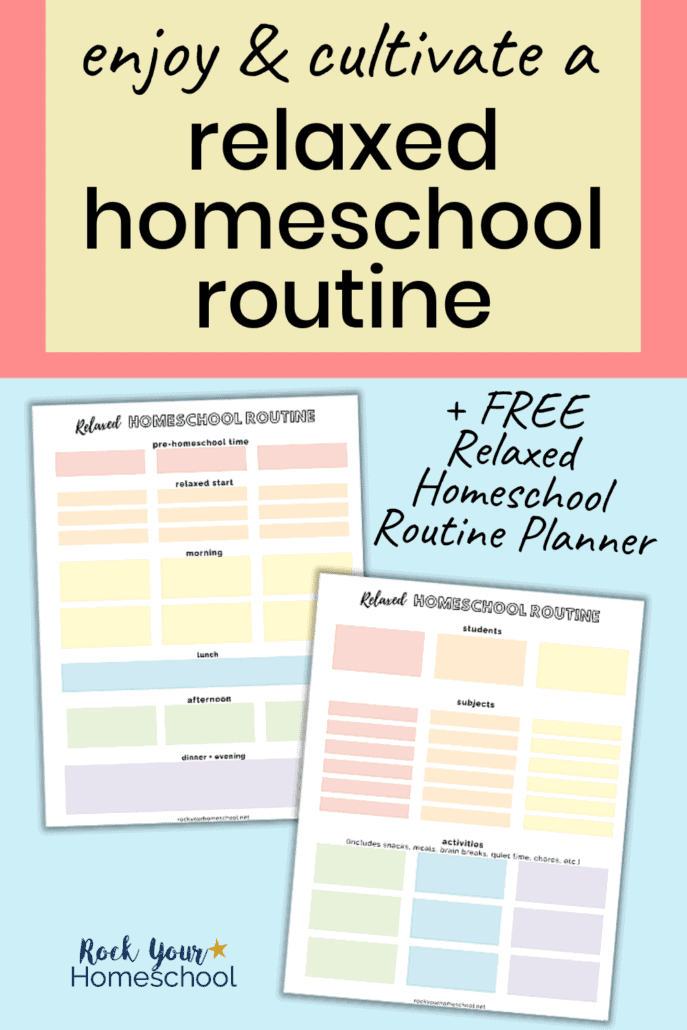10+ Smart Ways to Make a Daily Homeschool Schedule That Works for You
This post may contain affiliate links. Please read my disclosure statement. Thanks for visiting!
With a bit of creativity and these tips, you can create a daily homeschool schedule that works for you.
The best thing is that a schedule does not have to be rigid or boring. In fact, you'll discover how you can use a schedule to cultivate a routine that helps your homeschool adventures soar!

Creating a Daily Homeschool Schedule That Works for You
Homeschooling offers the freedom to tailor your child's education to fit their needs, strengths, and interests.
One of the advantages of homeschooling is the flexibility it affords families. However, with that flexibility can come the challenge of creating a daily schedule that ensures productivity while still maintaining the joy of learning.
Our relaxed eclectic homeschool actually thrives due in large part to our flexible daily schedule. My boys and I are able to get so much more done and enjoy our time together with our relaxed homeschool routine.

10 Daily Homeschool Schedule Ideas
Let's look at how to create a homeschool schedule that works for you and your family. And make sure to grab our free printable Positively Homeschool planner has a variety of sections that can help with these ideas and tips.
1. Understand Your Goals
Before creating a schedule, it's essential to understand what you want to achieve with homeschooling.
Are you focusing on a traditional curriculum (like boxed) or eclectic? Do you want to incorporate life skills, art, or music more often? Knowing what you aim for will guide your daily structure.
- Define the Purpose of Homeschooling
Ask yourself why you've chosen to homeschool. Is it to provide personalized attention? Perhaps it's to ensure that education aligns with your family's values? Or maybe it's to cater to your child's unique learning style or pace? Identifying the overarching purpose helps anchor all other decisions you'll make in the process.
- Traditional Curriculum vs. Customized Learning
Do you wish to follow the traditional education system closely so your child is on par with their peers in regular schools?
Or are you looking to craft a unique learning experience, weaving in subjects or topics that may not be part of the standard curriculum? Deciding between these approaches can influence everything from your daily schedule to the resources you invest in.
- Incorporating Interests and Passions
Homeschooling offers the chance to incorporate your child's interests and passions into their learning (plus electives and extracurricular activities). For example, if they're passionate about space, you can integrate astronomy more deeply into their science lessons. Or if they love art, you can offer them opportunities to explore different art forms in-depth.
- Adaptability for Future Goals
It's essential to think about the long-term as well.
Do you see your child transitioning back to a traditional school in the future? If yes, how can you prepare them for that transition? Alternatively, if you envision them continuing with homeschooling until college, how can you ensure they're well-prepared for that journey?

2. Know Your Child’s Rhythms
One of the most significant advantages of homeschooling is the ability to customize learning experiences to your child's natural inclinations and rhythms. While traditional schooling often demands a one-size-fits-all schedule, homeschooling allows for flexibility and personalization.
Understanding your child's rhythms is crucial in tapping into their highest potential. Let's break this down further:
- Observing Patterns
Begin by observing your child over a week or two without imposing a rigid schedule. Note when they seem most energetic, focused, or enthusiastic. Similarly, pinpoint the times they seem most fatigued or disinterested. These observations can provide invaluable insights into their natural rhythm.
- The Science Behind It
Every individual, including children, has an internal body clock called the circadian rhythm. This rhythm affects our energy levels, focus, mood, and overall cognitive function. By aligning learning activities with your child's circadian rhythm, you optimize their ability to absorb and retain information.
Oh, and I highly recommend establishing a calming bed routine!
3. Establish a Routine, Not Just a Schedule
While a schedule breaks down the hours and minutes of the day, a routine provides a flow to the day's activities. Routines can offer a sense of predictability without being restrictive.
For instance, instead of specifying that math will be from 10:00-11:00 am, decide that you'll start with a more challenging subject, followed by a creative activity, then a physical one. This way, you can adjust as needed without feeling like you're falling behind.
4. Factor in Breaks
Children, especially younger ones, can only focus for so long before they need a mental or physical break. Short, frequent breaks can help maintain their attention span and reduce burnout.
Consider using methods like the Pomodoro Technique, where you focus intensively for a set period (like 25 minutes) and then take a 5-minute break.

5. Incorporate Physical Activity
Physical activity isn't just good for health—it's also beneficial for learning. Movement boosts blood flow to the brain, aiding concentration and cognitive abilities. Incorporate short physical activities or games between subjects or take longer breaks to play outside.
Our free printable fitness game (with cootie catcher) is a fantastic way to do this!
6. Be Realistic
While it's tempting to fill each day with various subjects and activities, it's essential to be realistic about what you can achieve. Remember, in a traditional school setting, not every minute is spent on direct instruction. There's downtime, transitions between classes, lunch breaks, and so forth.
Your homeschool day doesn't need to—and shouldn't—be filled with academics from start to finish.
7. Allow for Flexibility
One of the greatest gifts of homeschooling is the flexibility. If your child is particularly engrossed in a project or subject, it's okay to diverge from the schedule and dive deeper into that area. Conversely, if something isn't working on a particular day, it's okay to set it aside and try again tomorrow.
8. Include Life Skills
Homeschooling offers an excellent opportunity to teach life skills alongside academic subjects.
Cooking can teach math and science. Budgeting and shopping can integrate math and critical thinking. And household chores can teach responsibility and work ethic. Be sure to weave these into your week.
9. Review and Adjust Regularly
What works for your family at one point might not work a few months down the line. Be ready to tweak.
Your child's sleep pattern may change, a new interest emerges, or you find a new curriculum that requires adjustment.
Regularly sit down, review your routine, and make changes as needed.
10. Seek Feedback
Involve your children in the scheduling process.
Chat with them about what they think is working and what isn't. You might be surprised at their insights. They'll also be more invested in a schedule they've had a say in creating.

Make the Most of Your Homeschool Day with a Schedule!
Creating a homeschool schedule that works for you is as much an art as it is a science. Remember that it's okay to adjust as you go along 😊
The goal is to foster a love for learning and create a balanced, fulfilling educational experience for your child.
And most importantly, have fun and enjoy the journey! The memories you create during this time will be cherished by both you and your child.



